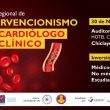Nearly all prostheses for transcatheter aortic valve replacement (TAVR) commercially available at present are adequate for most patients. However, there are certain subgroups, relatively small, that could benefit from a particular one. Yesterday we went over the best suited for small annuli, which turned out to be the self-expandable in general and the Evolut PRO<a href="https://solaci.org/en/2020/03/20/tavr-in-extremely-large-annuli-different-patients-might-need-different-prostheses/" title="Read more" >...</a>
Treating Both Atrial Valves Improves Survival
Courtesy of Dr. Carlos Fava. There a few treatment options for tricuspid valve disease. It is practically limited to diuretics and surgery, is associated to high mortality and, generally, mitral regurgitation. Developing the “edge-to-edge” strategy with MitraClip has been shown beneficial and, at present, there are studies that claim this technique could be greatly beneficial<a href="https://solaci.org/en/2020/03/10/treating-both-atrial-valves-improves-survival/" title="Read more" >...</a>
Percutaneous Annuloplasty in Functional Mitral Regurgitation vs. Sham Procedure
In cases where it is difficult to demonstrate the improvement of a drug or a device in hard endpoints such as mortality, we should look for softer and easier to prove endpoints. The problem is that these soft endpoints are often subjective (such as sensation of shortness of breath or angina pectoris) and they could<a href="https://solaci.org/en/2019/12/08/percutaneous-annuloplasty-in-functional-mitral-regurgitation-vs-sham-procedure/" title="Read more" >...</a>
Regional Course of Interventionism for the Clinical Cardiologist | with SOLACI’s Support
On November 30, 2019, the “I Regional Course of Interventionism for the Clinical Cardiologist” will take place in Chiclayo, Peru. The event will be held in the Muchick Room at Costa del Sol Hotel, organized by the Peruvian Society of Hemodynamics and Endovascular Interventionism (SOPHIE) with the support of SOLACI. The activity will be oriented to<a href="https://solaci.org/en/2019/11/13/regional-course-of-interventionism-for-the-clinical-cardiologist-with-solacis-support/" title="Read more" >...</a>
See the 2019 Bolivia Sessions presentations
The XXXVIII Regional SOLACI Sessions in Bolivia were an extremely successful scientific event. Renowned specialists in hemodynamics from all over Latin America presented their works and shared their knowledge in an event characterized by the utmost respect and comradeship. That is the reason why we share below those presentations, thanking these professionals for their contribution to<a href="https://solaci.org/en/2019/11/13/see-the-2019-bolivia-sessions-presentations/" title="Read more" >...</a>
FFR to Predict CABG Result: All Benefits in a Population Much Too Pure?
Coronary artery bypass graft (CABG) anastomosed to one vessel with normal or nearly normal fractional flow reserve (FFR) have poorer graft patency at one year compared against anastomosed grafts to vessels with functionally significant lesions shown by FFR. However, the recent study FARGO (Fractional Flow Reserve Versus Angiography Randomization for Graft Optimization) did not show<a href="https://solaci.org/en/2019/08/16/ffr-to-predict-cabg-result-all-benefits-in-a-population-much-too-pure/" title="Read more" >...</a>
How to Prevent Pharmacological Overtreating in the Elderly
Cardiovascular risk increases dramatically with over the years, which almost inevitable leads to treating the elderly with statins, based on risk. To prevent over treatment, we need to identify fragile patients (bed-ridden or with dementia), whose condition might make this treatment futile on the one hand, and on the other hand, patients who regardless their<a href="https://solaci.org/en/2019/07/26/how-to-prevent-pharmacological-overtreating-in-the-elderly/" title="Read more" >...</a>
ProEducar 2019 | We celebrate 10 Years of continuous interventional education!
The ProEducar Fellow Course is a special event designed for fellows or interventional trainees seeking to update their knowledge and perfect their skills on interventional cardiology. This intensive and quality event introduces four interventional modules focused on practice rather than theory, with step-by-step demonstrations, tips and secrets of the trade, and educational cases. The course<a href="https://solaci.org/en/2019/07/21/proeducar-2019-we-celebrate-10-years-of-continuous-interventional-education/" title="Read more" >...</a>
Nonobstructive Coronary Lesions and Ventricular Dysfunction
Many patients arrive to the cath lab for a diagnostic coronary angiography after an echo showing severe ventricular dysfunction, even in asymptomatic patients. In many occasions, their coronary arteries are normal, and in many others, we find coronary disease that is not enough to warrant such severe ventricular dysfunction. Patients with heart failure are frequently<a href="https://solaci.org/en/2019/05/17/nonobstructive-coronary-lesions-and-ventricular-dysfunction/" title="Read more" >...</a>
Subclavian and Axillary Access for TAVR: a Valid Alternative
Courtesy of Dr. Carlos Fava. The femoral approach is preferred when it comes to TAVR, but sometimes it is not viable. This is when other access sites come into play, such as the trans-subclavian/axillary (TS/TAx), the apical, transcaval, transcarotid (TC) or transaortic. At present, few studies have looked into this matter, which is why it<a href="https://solaci.org/en/2019/04/11/subclavian-and-axillary-access-for-tavr-a-valid-alternative/" title="Read more" >...</a>









